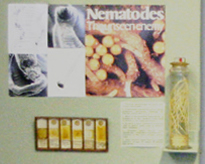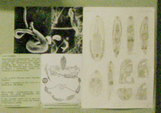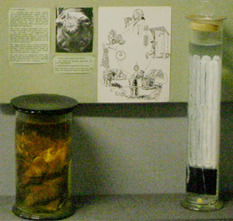
PARASITIC WORMS
The parasitic worms – platyhelminthes, nematodes, nematomorphs, acanthocephalans - and the worm-like pentastomes are displayed side by side, irrespective of their evolutionary origins. This arrangement emphasises the features, which have evolved many times as adaptations to a parasitic way of life:
- hooks and suckers for attachment and feeding;
- proliferation of gonads to increase reproductive capacity of adults;
- proliferative intermediate stages; resistant, shelled eggs;
- free-living dispersive stages;
- ability to withstand the host’s digestive enzymes or immune system.
The Nematoda, Nematomorpha and Acanthocephala share many features: a pseudocoelom, a cuticle, a digestive tract complete with mouth and anus, separate sexes and small size. Many species of nematodes are either partially or entirely parasitic, nematomorphs are parasitic for part of their lives and acanthocephalans for all of their lives.
|
||||||||||||||||||||||||||||||||||||||||||||||||||||||||||||||||||||||||||||||||||||||||||||||||||||||||||||||||||||||||||||||||||||||||||






















